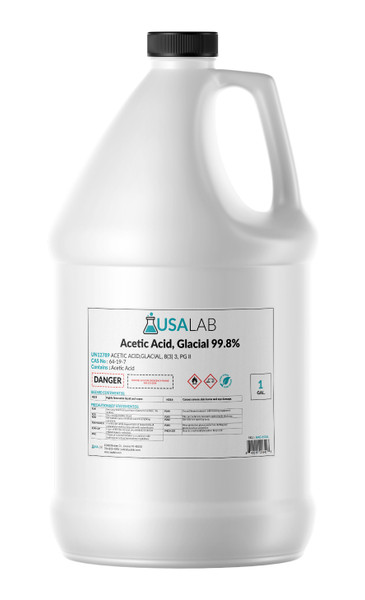-


USA Lab Hexane 99.5% High Purity Lab Grade
USA LabHEX-Sale $18.00 - $699.00RetailHexane 99.5% High Purity Lab Grade | USA Lab *Hazmat fee applied at checkout* -


USA Lab High Purity Lab Grade Heptane 99%
USA LabHEPTANE-Sale $18.00 - $610.00RetailHigh Purity Lab Grade Heptane | USA Lab *Hazmat fee applied at checkout***5 gallon size shipped in metal container** -


USA Lab Food & Lab Grade Glacial Acetic Acid 99.8%
USA LabAAG-Sale $21.00 - $1,200.00RetailUSA Lab Food & Lab Grade Glacial Acetic Acid 99.8% Acetic acid, also known as ethanoic acid, is a highly versatile organic compound integral to various industries and everyday life. It -


USA Lab N-Hexane 99.5% High Purity Lab Grade
USA LabNHEX-Sale $29.00 - $1,050.00RetailUSA Lab High Purity Lab Grade N-Hexane -


USA Lab n-Heptane Pure Grade 99.3%
USA LabN-HEP-Sale $24.00 - $1,199.00Retailn-Heptane Pure Grade 99.3% | USA Lab *Hazmat fee applied at checkout*
Description
Data Sheet
Dichloromethane (DCM) - USA Lab
*Hazmat fee applied at checkout*
Dropship Item
Lab Grade Dichloromethane (99.99% Purity, aka Methylene Chloride)
Dichloromethane (DCM), also known as methylene chloride, is a high-purity organochloride chemical. It is a colorless, volatile liquid with a sweet, chloroform-like odor, widely used as a solvent in various industries. Although it has limited solubility in water, DCM is polar and mixes well with most organic solvents.
Common Uses of Dichloromethane (DCM)
Solvent in Laboratory and Industrial Applications
Dichloromethane is a valuable solvent due to its ability to dissolve a wide range of organic compounds. It is extensively used in chemical processes and as a cleaning agent in both laboratory and industrial settings.
Data Sheet
|
Chemical Formula: |
CH2Cl2 |
|
Molecular Weight: |
84.93 g·mol−1 |
|
CAS Registry Number: |
75-09-2 |
|
Appearance |
Colorless Liquid |
|
Odor: |
Faint, Chloroform-like |
|
Density |
1.3266 g/cm3 (20 °C) |
|
Boiling Point: |
39.6 °C / 103.3 °F |
|
Solubility in water: |
17.5 g/L (25 °C) |
|
GHS Signal Word: |
Warning |
|
GHS Hazard Statements: |
H315, H319, H335, H336, H351, H373 |
|
GHS Precautionary Statements |
P261, P281, P305+P351+P338 |
|
UN Identification Number: |
1593 |
|
Proper Shipping Name: |
Dichloromethane |
|
Transport Hazard Class: |
6.1 |
|
Packing Group: |
III |
Common Uses of Dichloromethane
1. Solvent in Laboratory and Industrial Applications
Dichloromethane is an invaluable solvent due to its ability to dissolve a wide range of organic compounds. It's frequently used in chemical processes and as a cleaning agent.
2. Extraction Processes
DCM is extensively employed in the food and beverage industry, notably in the decaffeination of coffee and tea. It effectively extracts caffeine while preserving other flavor compounds. Due to its density of 1.33g/cm³, DCM forms the bottom layer during liquid-liquid extraction, simplifying the separation process.
3. Chemical Reactions
Dichloromethane serves as a solvent and reagent in numerous synthetic procedures, aiding in efficient chemical reactions.
4. Pharmaceutical Applications
In the pharmaceutical industry, DCM is used for various purposes, including drug formulation, owing to its solvent properties.
5. Aerosol Propellant and Foaming Agent
DCM has been used as a propellant in aerosol products like paints and coatings, and as a foaming agent in the production of polystyrene foam.
6. Laboratory Applications
DCM is essential in laboratory settings, especially for chromatography, due to its solvent properties.
Properties of Dichloromethane
- Physical State: At room temperature, DCM is a volatile liquid with a sweet, ether-like odor.
- Density: Approximately 1.33 grams per milliliter (g/mL), making it denser than water.
- Solubility: DCM is highly miscible with many organic solvents, including ethers and alcohols, but has limited water solubility.
- Boiling Point: 39.8°C (103.3°F), facilitating rapid drying and preservation of temperature-sensitive compounds.
- Reactivity: Chemically stable under normal conditions but reacts with strong bases like sodium hydroxide.
- Flammability: Not highly flammable but can form flammable mixtures with air under specific conditions.
- Toxicity: Hazardous due to potential health risks, including skin and eye irritation, CNS depression, and carcinogenicity.
Safety Precautions for Handling Dichloromethane
To ensure safety when handling dichloromethane, follow these guidelines:
- Personal Protective Equipment (PPE): Use chemical-resistant gloves, safety goggles or face shields, and lab coats or chemical-resistant aprons. For large quantities, full-body protective clothing is recommended.
- Ventilation: Operate in a well-ventilated area, ideally under a chemical fume hood.
- Respiratory Protection: Use a NIOSH-approved organic vapor respirator if ventilation is inadequate.
- Storage: Store DCM in a cool, well-ventilated area away from sunlight, heat, and incompatible materials, ensuring containers are tightly sealed and properly labeled.
- Handling: Avoid unnecessary exposure, prevent spills, and refrain from eating, drinking, or smoking while working with DCM.
- Skin and Eye Contact: Prevent contact with skin and eyes by using appropriate PPE and immediate washing if contact occurs.
- Fire Safety: Keep DCM away from ignition sources and ensure fire extinguishing equipment is accessible.
- Emergency Procedures: Familiarize yourself with emergency protocols, including the locations of eyewash stations, safety showers, and spill response kits.
- Disposal: Dispose of DCM waste according to local regulations, as it is often classified as hazardous.
- Training: Ensure all personnel are adequately trained in the safe handling, storage, and disposal of DCM.
By adhering to these precautions and safety guidelines, you can minimize the health and environmental risks associated with dichloromethane. Always consult the safety data sheet (SDS) and local regulations for additional information and guidance.
Lead times may vary. Please call for current availability.
For Technical Support, Questions, or Other Issues Please Email or Call Us!

















